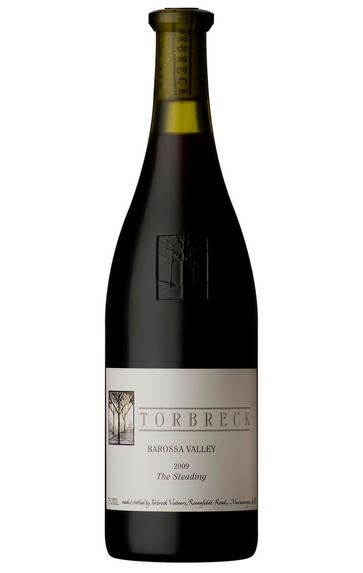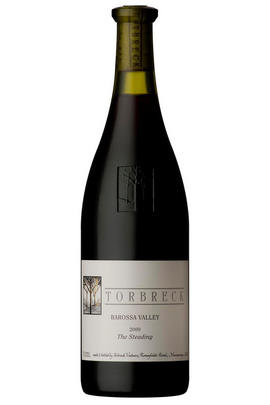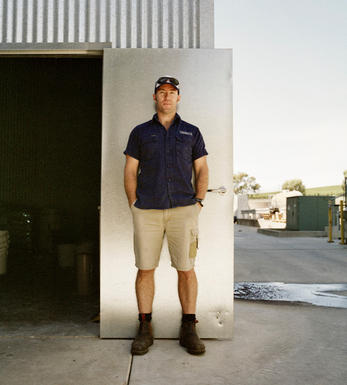
2009 Torbreck, The Steading, Barossa Valley, Australia

Critics reviews
Lisa Perrotti-Brown - 28/02/2013
About this WINE

Torbreck
Torbreck was established in 1994 and is located at Marananga on the western ridge of the Barossa Valley. It is named after a forest situated just south of Inverness in the Highlands of Scotland. Founded by David Powell, a former lumberjack who worked in various vineyards to hone his oenological skills, Torbreck’s first releases in 1997 of a 1995 Runrig (Shiraz/Viognier) and 1996 The Steading (Grenache/Mataro/Shiraz) were greeted with rapturous applause by critics and connoisseurs alike. The winery is overseen by Senior Winemaker Craig Isbel and his team.
The overwhelming majority of his vines are dry-grown, nearly all are 100 - 165 years old and are tended and harvested by hand. The wines have an extraordinary combination of power, intensity, complexity and great finesse.

Barossa Valley
Barossa Valley is the South Australia's wine industry's birthplace. Currently into its fifth generation, it dates back to 1839 when George Fife Angas’ South Australian Company purchased 28,000 acres at a £1 per acre and sold them onto landed gentry, mostly German Lutherans. The first vines were planted in 1843 in Bethany, and by the 1870s – with Europe ravaged by war and Phylloxera - Gladstone’s British government complemented its colonies with preferential duties.
Fortified wines, strong enough to survive the 20,000km journey, flooded the British market. Churchill followed, between the Wars, re-affirming Australia’s position as a leading supplier of ‘Empire wines’. After the Second World War, mass European immigration saw a move to lighter wines, as confirmed by Grange Hermitage’s creation during the 1950s. Stainless-steel vats and refrigeration improved the quality of the dry table wines on offer, with table wine consumption exceeding fortified for the first time in 1970.
Averaging 200 to 400 metres’ altitude, the region covers 6,500 hectares of mainly terra rossa loam over limestone, as well as some warmer, sandier sites – the Cambrian limestone being far more visible along the eastern boundary (the Barossa Ranges) with Eden Valley. Following a diagonal shape, Lyndoch at the southern end nearest Gulf St Vincent is the region’s coolest spot, benefiting from sea fogs, while Nuriootpa (further north) is warmer; hot northerlies can be offset by sea breezes. The region is also home to the country’s largest concentration of 100-year-old-vine Shiraz, Grenache and Mourvedre.
Barossa Valley Shiraz is one of the country’s most identifiable and famous red wine styles, produced to a high quality by the likes of Rockford, Elderton, Torbreck and Dean Hewitson. Grenache and Mourvèdre are two of the region’s hidden gems, often blended with Shiraz, yet occasionally released as single vineyard styles such as Hewitson’s ‘Old Garden’, whose vines date back to 1853. Cabernet Sauvignon is a less highly-regarded cultivar.
Wines are traditionally vinified in open concrete fermenters before being cleaned up and finished in American and French oak barrels or ‘puncheons’ of approximately 600 litres. Barossa Shiraz should be rich, spicy and suave, with hints of leather and pepper.

Southern Rhône Blend
The vast majority of wines from the Southern Rhône are blends. There are 5 main black varieties, although others are used and the most famous wine of the region, Châteauneuf du Pape, can be made from as many as 13 different varieties. Grenache is the most important grape in the southern Rhône - it contributes alcohol, warmth and gentle juicy fruit and is an ideal base wine in the blend. Plantings of Syrah in the southern Rhône have risen dramatically in the last decade and it is an increasingly important component in blends. It rarely attains the heights that it does in the North but adds colour, backbone, tannins and soft ripe fruit to the blend.
The much-maligned Carignan has been on the retreat recently but is still included in many blends - the best old vines can add colour, body and spicy fruits. Cinsault is also backtracking but, if yields are restricted, can produce moderately well-coloured wines adding pleasant-light fruit to red and rosé blends. Finally, Mourvèdre, a grape from Bandol on the Mediterranean coast, has recently become an increasingly significant component of Southern Rhône blends - it often struggles to ripen fully but can add acidity, ripe spicy berry fruits and hints of tobacco to blends.


Buying options
Add to wishlist
Description
The 2009 Steading is composed from the traditional Barossa cultivars of Grenache, Shiraz and Mataro. It has long been David Powell’s favourite wine within the Torbreck stable because of the old, gnarled ‘bush vines’ that produce its core. This is almost Burgundian in style, and is perhaps the wine that represents what Torbreck is all about: old vines (on pre-phylloxera rootstock), from a selection of plots, vinified separately then blended once their individual strengths and characteristics are clear, producing a wine whose most notable feature is its soft and lifted texture, backed up by the weight that you would associate with this part of the New World.
(BBR Fine Wine)
wine at a glance
Delivery and quality guarantee